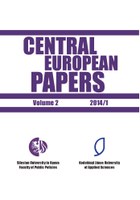The German Occupation of Cluj – Kolozsvár and its Consequences on the History of the City in 1944
The German Occupation of Cluj – Kolozsvár and its Consequences on the History of the City in 1944
Author(s): János Kristóf MurádinSubject(s): History
Published by: Slezská univerzita v Opavě, Fakulta veřejných politik
Keywords: Wehrmacht; invasion; occupation; Gestapo; Jews; concentration camp; ghetto; deportation; Holocaust; citizens; indignation; fear
Summary/Abstract: This year, there is the 70th anniversary of the German occupation of Hungary. Therefore, with this study I would like to commemorate this very important historical event, which had decisive effects on the future of the Hungarian state and society as well. Naturally, until nowadays there have appeared a lot of books, studies and scientific articles which present the occupation, but most of them deal with the problem in general, referring to the whole country. In order to complete the general scene, in my study I focused only on the capital of the Northern Transylvanian region, reincorporated to the Hungarian Kingdom in 1940. The city of Kolozsvár (today, officially in Romanian language: Cluj-Napoca) was the administrative and cultural center of the eastern part of Hungary in that time, therefore it shows very well the exact consequences of the occupation. First of all, I shortly presented the political and military conditions of the German invasion of the country, and after that, the occupation process of Kolozsvár. For a better description of the entering of Wehrmacht troops in the city, I used some interviews made to persons who were eye-witnesses to the events. Beside these, I obtained a lot of data from the local contemporary Hungarian and Romanian press, and several scientific publications and articles published recently. The main objective of this study is to realize an analysis of exact consequences of the German occupation of Kolozsvár in 1944 upon the population of the city, and especially upon the Jewish community. Through the description of the mass arrests of left wing sympathizers, and the collection of the Jews in ghettos, as well as the deportation process, I tried to present one of the most dramatic period of the old, historical city of Kolozsvár.
Journal: Central European Papers
- Issue Year: 2/2014
- Issue No: 1
- Page Range: 74-87
- Page Count: 14
- Language: English

